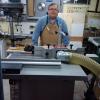After looking at past discussions and the internet, I've come up with the following plan for building beaded face frames. The work load includes a kitchen, bath, and frame & panel construction on deep stone walls around windows.
Equipment
Felder KF700SP with 1.25" and router spindles
Kreg 1/4" x 1.5" notching bit
Freeborn PC-17-041 bead cutter
Procedure
Follow this procedure for notches (KF700 shaper, router spindle, Kreg)
Slide the shaper fence over to chamfer rails (KF700 shaper, router spindle, Kreg)
Cut the beads (KF700 shaper, shaper spindle, Freeborn)
Glue and pocket screw
I'd appreciate any suggestions.





 Reply With Quote
Reply With Quote


